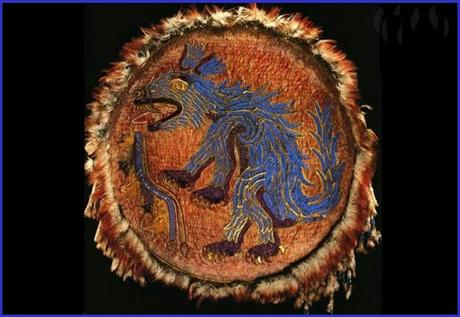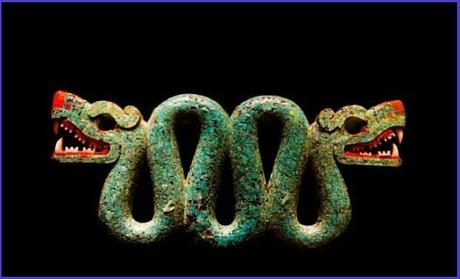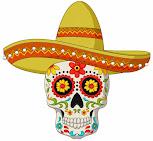Mexico has a rich mythical bestiary which is well worth investigating. I don't propose to regale you with tons of information about all of its terrifying creatures here - there is plenty of detailed source material out on the internet if you're interested - but let me what your appetite with a high-level pass through ten of the most intriguing.

Ahuitzotl (embroidered feather shield)
Ahuitzotl: this spiny aquatic doglike creature of Aztec mythology was an agent of the water gods and would rise up out of lake or river to snatch human prey from the shore and devour it.Cadejo: another dog-like creature of Mayan folklore, possessed of supernatural powers, it manifested itself to lone wanderers by night in one of two forms: the white as guard and guide, the black as malign and deadly.
Camazotz: an enormous bat which presided over death and sacrifice, its specialty was lopping off its victims heads so the gods could use them to play ball games with.
Chupacabra: literally "goat-sucker", this bear-like humanoid with a row of spines from head to tail lived by draining the blood of livestock - and there are even reputedly contemporary sightings.
Cipactli: in Aztec mythology this primeval sea monster was part crocodile, part fish, part frog and was always hungry, every joint in its body being adorned with an extra mouth.
Coco: a shape-shifting Mexican bogeyman or woman (Coca) inhabiting the shadowlands, with a predilection for stealing and devouring children, particularly naughty ones.
Nahual: another shape-shifting supernatural being, wizard or witch, capable of either good or evil depending on their dominant personality, and central to some shamanistic rites.
Quetzalcoatl: a feathered snake and one of the four sons of the primordials, he was the Aztec god of the sun, air, winds and wisdom, bedecked with wind jewels and worshipped with animal (but not human) sacrifices.
Tlahuelpuchi: a vampiric witch with powers of lycanthropy, she was herself the victim of a curse, co-existed with her human family and sucked the blood of infants and animals at night, causing their bodies to glow.
Xiuhcoatl: another snake or serpent, regarded as the spirit form of the Aztec fire deity, a double-headed abettor of the sun god in his daily battle against darkness, the moon and the underworld.

Xiuhcoatl (fire serpent)
Any of you familiar with the films of Guillermo del Toro will know that Mexico's rich tradition of fantastic imaginary monsters lives on in his work. Born in Guadalajara in 1964, GdT was making short films by the age of eight using his father's Super 8 camera. He has a lifelong fascination with monsters, which he considers to be symbols of great power, and many of his films have significant elements of fairy-tale and horror. He also trained as a special effects designer and formed his own company, Necropia, from which he has furnished the creations for some of his most famous films, including the award-winning 'Pan's Labyrinth ' and 'The Shape Of Water '. He also has a horror-series via Netflix, 'Guillermo del Toro's Cabinet Of Curiosities'. He regards the horror genre as essentially political: "Much like fairy-tales there are two facets of horror. One is pro-institution, which is the most reprehensible type of fairy-tale: Don't wander into the woods and always obey your parents. The other type of fairy-tale is completely anarchic and anti-establishment." Watch out for his animated take on 'Pinocchio ', re-imagined during the rise of Mussolini. It should be in cinemas later this month.
One of Guillermo del Toro's monsters
To conclude, sixteen lines about living sacrifice, a significant part of the Aztec and Mayan civilizations of pre-Columbian Central America.Death Drips Cruel JewelsBixbite tears, fire opal beads of Querétaro,merciless as any monster's bloodshot eye,garnet, ruby, topaz, tourmaline congealedin scorching sands, swarmed over by flies in shameless lust for life, each can spawn a cactus whose lethal thorns warn carefulhow you go but whose sudden floweringswith blooms as magnificent as sombreros
seduce even as they scare. So still we toil,death-bound on each dread step sunwards,lungs hungry for thin air, stricken by fearsof the flashing blade, rent chests, savaged
youth. How we die - mercy - how we die! In screaming spasms, heart's blood spurtsa scarlet rain, pumping out in mescal painto nourish the velvet vultures of the skies.

Thanks for reading, S ;-)
